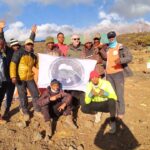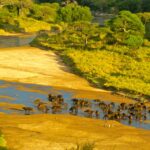Table of Contents
2025 Kilimanjaro Climbing Predictions: What to Expect on the Mountain in the New Year
Kilimanjaro Climbing Predictions 2025 offer valuable insights for adventurers planning to conquer Africa’s tallest peak. Every year, Mount Kilimanjaro—the tallest peak in Africa—lures many climbers into its glaciers and sweeping landscapes. With the advent of 2025, questions are being raised regarding the new year for a successful summit.
Here is some general information about expected trends, weather, crowd levels, and upcoming new regulations in 2025 that are going to make you very well prepared for your Kilimanjaro Climbing Predictions 2025 adventure.
Table of Contents
- Overview of Kilimanjaro Climbing Trends
- Weather Predictions for 2025 Climbing Seasons
- Crowd Levels & Popular Routes
- New Regulations and Sustainability Efforts
- Preparation Tips for 2025 Climbers
1. Overview of Kilimanjaro Climbing Trends
Over the past couple of years, eco-sensitive climbers have started to head to Kilimanjaro in droves. The year 2025 is no different. The new sustainability measures put into place will affect climbers and the environment in equal measures around Kilimanjaro. More and more, different climbers are starting to appreciate the importance of eco-friendly gear on treks, minimal-impact methods of camping, and respect for Tanzania’s natural heritage. Tour companies respond by offering sustainable package options and guide training to reduce the impact on the fragile mountain ecosystem. The “leave-no-trace” policy has become part of every climber’s journey, making it not just about personal accomplishment but about preserving Kilimanjaro for future generations.
2. Weather Predictions for 2025 Climbing Seasons
Weather conditions on Kilimanjaro are an essential determinant of a successful climb, with temperatures and precipitation levels changing radically through the different climatic zones from base to summit. For 2025, meteorologists predicted a little above average in temperature and erratic rain fluctuation. This is extremely important for the climbers; fluctuating rain patterns would definitely affect trail conditions and visibility. Here is a breakdown of the expected weather for each climbing season:
| Climbing Season | Expected Weather Conditions | Best Routes |
|---|---|---|
| January – March | Warm, sometimes rain | Machame, Marangu |
| April to May | Heavy rains, traveling conditions not comfortable; Not recommended to travel | |
| June – October | Coolest, driest, best, clearest skies | Lemosho, Rongai |
| November to December | Light rains, warm temperatures | Marangu, Machame |
- January to March: January to March. The months of January to March are normally considered off-season. Those who prefer fewer people and milder temperatures will find this period perfect. With less rainfall compared to the months later in the year, this can be a time that provides comfort and challenge to climbers, thus being quite well-rounded for all climbers.
- April to May: This period has the long rainy season with heavier rains, turning trails to mud and visibility low; hence, this time of the year is less preferred for summiting. However, to those climbers who can brave these conditions, it ensures that this is the least busy period.
- June to October: This is considered the high climbing season, where the months are cool and dry, hence guaranteeing clear skies and stable weather; this makes climbers want to have clear views at the summit. The only setback of this option is that during these months, the trails are more crowded.
- November to December: During this short rain period, conditions are somewhat mild and crowds are moderate; this makes it a good option for those who do not want really full trails, as happens during the peak season.
3. Crowd Levels & Popular Routes
The growing popularity of Kilimanjaro means certain routes experience higher traffic, especially during the high season from June to October. The Northern Circuit and Rongai Route have recently gained attention as quieter options for those looking to escape the crowds in 2025. The Northern Circuit offers a longer trek with excellent acclimatization opportunities, while Rongai provides scenic views from the mountain’s northern side, often less crowded than other routes.
Popular routes to consider in 2025:
- Machame Route It has great scenic landscapes and enjoys a relatively higher summit success rate; hence, it is popular but often crowded during peak periods.
- Marangu Route: It is the only route which has hut accommodations, and this plus factor makes it especially appealing during the rainy season.
- Lemosho Route: It features few people, a more gradual climb, and highly diversified flora and fauna.
4. New Regulations and Sustainability Efforts
More recently, the country of Tanzania has started to take more into consideration the environmental impact that the increase of tourism flow: Further sustainability measures for 2025, giving even more importance to the conservation of Kilimanjaro, now include:
- Stricter waste management protocols: Trekkers will need to carry garbage along with them, and guides are supposed to leave the campsites clean.
- Single-use plastic bans: Due to pollution reasons, trekkers are not allowed to carry single-use plastics like bottles and bags on the mountain.
- Eco-friendly campsites: newly established eco-accredited campsites feature facilities that are non-destructive to the environment and dispose of wastes effectively.
These policies are putting much emphasis on sustainable tourism; hence, climbers have to equip themselves with meeting these new standards lest they face penalties and in preserving the natural environment of Kilimanjaro.
5. Preparation Tips for 2025 Climbers
Successfully summiting in 2025 requires being abreast of regulations and climatic expectations, among others. Some preparatory tips include the following; note that:
- Train for altitude: he altitude of Kilimanjaro is one that subjects a person to altitude sickness. Training with hikes at high altitudes-if possible-and choosing routes with gradual ascents will be very helpful in acclimatizing you.
- Choose quality gear: Dressed accordingly in several layers for changeable mountain weather conditions and necessary equipment to have the best possible trekking experience. Quality equipment will make sure you are dry from cold temperatures and possibly rain right at the summit down to high altitudes.
- Book early for peak season: The months from June through October have restricted climbing permits and a limited number of accommodations. Make an advance booking to avoid last-minute issues.
- Follow regulations closely: Normally, know the waste management policy and ban on single-way plastics to respect these recommendations as the success of your journey and the conservation of the mountain depend on this.
Kilimanjaro Climbing Predictions 2025 highlight the most critical aspects of planning a climb on Africa’s tallest mountain. With strategic preparation, including respect for Kilimanjaro’s natural environment, 2025 should be an excellent year for climbers in search of challenge and wonder on Africa’s Roof.
Whether it’s your first summit or a repeat adventure, being informed about Kilimanjaro Climbing Predictions 2025 will ensure a safe, memorable, and successful trek. The mountain’s allure lies not only in its glaciers and sweeping landscapes but also in the unique challenges and opportunities each year brings.
Why Focus on Kilimanjaro Climbing Predictions 2025?
Kilimanjaro Climbing Predictions 2025 reveal expected weather conditions, crowd levels, and new regulations to help climbers make informed decisions. Climbers can prepare for varying weather patterns and take advantage of quieter seasons while respecting conservation efforts that safeguard the mountain’s beauty.
What’s New in Kilimanjaro Climbing Predictions 2025?
In Kilimanjaro Climbing Predictions 2025, sustainability takes center stage. Stricter waste management policies and a ban on single-use plastics emphasize the importance of preserving Kilimanjaro’s fragile ecosystem. Climbers are encouraged to adopt eco-friendly practices, ensuring that their adventure leaves a minimal footprint.
Weather Insights from Kilimanjaro Climbing Predictions 2025
Weather plays a pivotal role in Kilimanjaro Climbing Predictions 2025. Each climbing season brings its own challenges:
- January to March: Milder temperatures with fewer crowds.
- June to October: Dry season with clear skies, ideal for summiting.
- November to December: Moderate conditions, perfect for avoiding peak-season crowds.
These insights from Kilimanjaro Climbing Predictions 2025 ensure climbers choose the best time for their trek.
Crowd Levels According to Kilimanjaro Climbing Predictions 2025
Popular routes like the Machame and Marangu trails are expected to see high traffic during peak seasons. However, Kilimanjaro Climbing Predictions 2025 suggest quieter alternatives like the Northern Circuit and Rongai Route, ideal for those seeking solitude and breathtaking views.
Preparing for Success with Kilimanjaro Climbing Predictions 2025
Training, gear selection, and early bookings are critical components of Kilimanjaro Climbing Predictions 2025. Trekkers are advised to:
- Train for altitude to reduce the risk of sickness.
- Invest in quality gear to withstand Kilimanjaro’s varying climates.
- Book accommodations early, especially during the high season.
Conclusion
By following Kilimanjaro Climbing Predictions 2025, adventurers can fully embrace the challenges and wonders of Africa’s Roof. Respect for Kilimanjaro’s environment, adherence to new regulations, and strategic planning will make 2025 a year to remember for climbers around the globe. Let Kilimanjaro Climbing Predictions 2025 guide you toward an unforgettable experience on this iconic mountain.
















